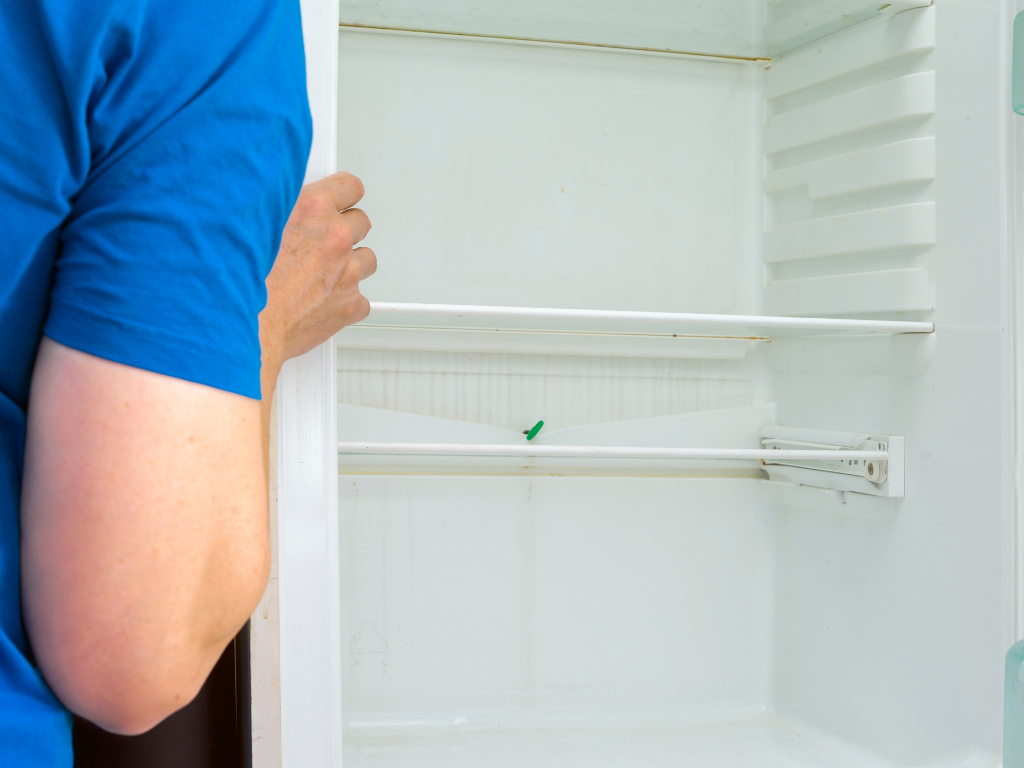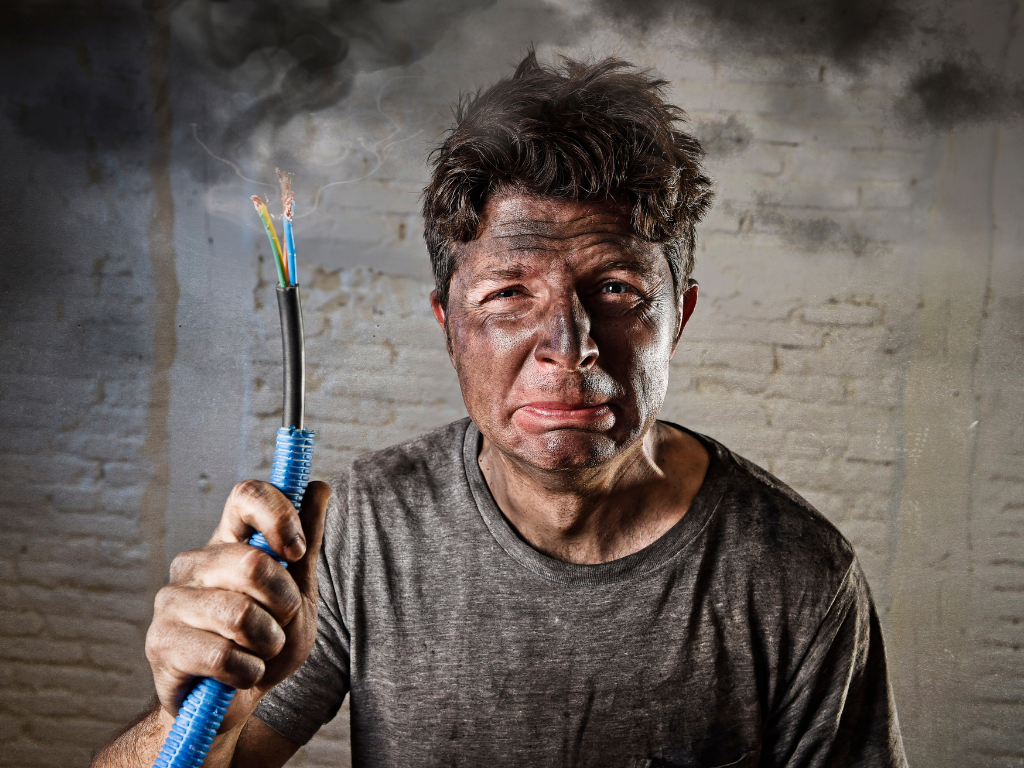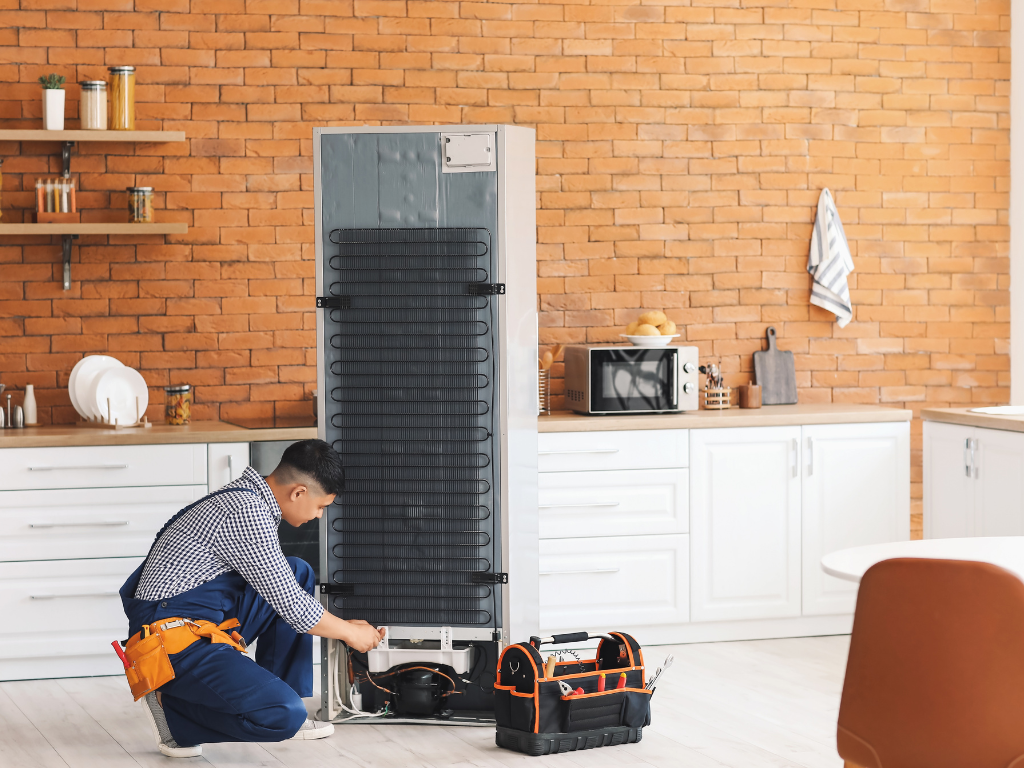6 Causes of a Burning Smell from the Fridge (Plus Fixes!)
Do you smell a burning smell from the fridge? Though unlikely, this scenario can provide some cause for concern. In this article, we’ll explain where to look to determine the source of the smell, as well as how to fix the problem.
A burning smell from the fridge may be caused by a loose wire connection in the wall outlet, a malfunction in the fridge’s plug, a faulty power cord, the wiring and starter relay surrounding the compressor, dirty condenser coils, or the internal lightbulb.
Each of these scenarios will leave discernable signs that should help you identify the source. Keep reading for more information on a burning smell from the fridge.

What to Do when you sense a burning smell from the fridge
If you smell a burning smell from the fridge, the first thing you should do is switch off the power to the fridge by turning off the associated breaker in your breaker box.
Don’t simply unplug the fridge cord from the wall if you smell burning because a malfunctioning outlet or power cord could be the source of your problem. It’s best to turn off the power without touching these areas. If you’re using an RV fridge that is running off of propane, switch the propane off.
Once the breaker is switched off, unplug the fridge from the wall outlet. Just make sure to test the heat of the cord or outlet before simply reaching out and touching them. In some cases, they may be extremely hot or still contain some electric current.
At this point, you’ll want to locate the source of the burning smell. With the fridge still switched off, conduct a preliminary inspection of the fridge to locate the source of the smell. Thoroughly inspect the fridge body – interior, back, power cord, top plug, and wall outlet for the possible source of the burning smell.
Where is the burning smell strongest? Do you see any burn marks anywhere? This helps you identify places where you should focus your troubleshooting efforts.
Here is a chart of these quick action steps:
| Step | Action to Take | Note / Warning |
|---|---|---|
| Step 1 | Turn off the power to the fridge | Locate the associated breaker in your breaker box and turn it off. Do not simply unplug the fridge. |
| Step 2 | For RV fridges running on propane, switch the propane off | This step is specific for RV fridges running on propane. |
| Step 3 | Unplug the fridge from the wall outlet | Before touching, test the heat of the cord or outlet as they may be hot or carry residual electric current. |
| Step 4 | Locate the source of the burning smell | Conduct a preliminary inspection of various parts of the fridge including the interior, back, power cord, top plug, and wall outlet. |
The following list includes common causes of a burning smell from the fridge:

1. Check the Wall outlet for signs of burning
Does the wall outlet have any burning smell? A loose wire connection in the outlet can give off sparks, causing heat buildup and the burning smell from the hot insulation and plastic. This may leave the plastic outlet cover slightly melted or blackened by the heat.
How to fix a scorched wall outlet
The exact causes of a scorched wall outlet can vary. For the most part, this problem reveals an issue with the load on that particular outlet. If you had multiple appliances plugged up to this outlet, it could have caused a surge that was larger than what the outlet could handle. Typically with large appliances such as a refrigerator, you’ll want to have it on its own outlet.
Warning: Unless experienced with electrical systems, it’s usually best to let a professional electrician handle outlet repairs.
To fix a scorched wall outlet from an overloaded circuit, first, make sure the power is shut off from the breaker.
Fixing Outlet Short Circuit:
- Unplug appliances and turn off main power.
- Test terminals with a voltage tester.
- Remove faceplate and outlet carefully.
- Replace with arc-fault circuit interrupter (AFCI) or ground fault circuit interrupter (GFCI) outlet.
- Loosen screws holding wires to inspect them.
- Look for wire damage.
- Discard burnt outlet.
- Install new outlet.
Removing Burnt Wire:
- Cut burnt wire using wire strippers.
- Use knife or box-cutter to strip wire insulation back 1/2 – 3/4 of an inch.
- Twist wire ends with a wire nut.
- Connect new outlet: black wire to gold terminal, white wire to silver, green wire to green (or brown/copper).
- Secure with electrical tape.
- Neatly place wires in outlet box.
- Screw in new outlet.
- Attach faceplate.
Again, if you feel uncomfortable with this process, it may be best to call a licensed electrician to take care of the issue for you. Working with electricity can be dangerous. Don’t put yourself in harm’s way to save a few bucks!
2. Inspect the Fridge’s plug for damage
Damage to the fridge’s plug can give off sparks that heat and give off a distinct burning smell. If this is the case with your fridge, you’ll likely need to replace the damaged plug and perhaps the entire power cord. Here’s how:
How to Replace your fridge’s plug when faulty
Replacing the plug on your fridge’s power cord can be a bit challenging, so make sure to heed the following warning whenever you decide to work with electricity:
Warning: Unless experienced with electrical systems, it’s usually best to let a professional electrician handle plug repairs.
Removing Power Cord Plug:
- Get matching replacement plug from hardware store or online.
- Unplug cord from both ends.
- Cut wire below plug with wire cutters.
- Strip 3/4 inch cord jacket.
- Strip 1/2 inch insulation from wires.
- Bend wire ends into U-shape.
Install New Plug:
- Unscrew new plug housing.
- Slide base onto cord if detachable.
- Loosen terminal screws.
- Insert wires into correct terminals (green-ground, silver-neutral, brass-hot).
- Tighten screws to secure wires.
- Assemble new plug housing.
Again, make sure you know what you’re doing before attempting this on your own. Plugging a DIY cord into the wall could result in electric shock if you weren’t careful to follow all of these steps correctly.

3. Inspect and/or smell the power cord
The next thing you ought to check for is broken insulation or burn marks on the power cord itself. If you find this to be the case, you’ll need to replace the power cord in its entirety. Follow the steps below to do so safely.
How to replace a malfunctioning refrigerator power cord
To replace a malfunctioning refrigerator power cord, you’ll need to make sure you follow all safety precautions and contact a certified electrician if you ever feel you are in danger.
Warning: Unless experienced with electrical systems, it’s usually best to let a professional electrician handle cord repairs.
If you decide to do the work yourself, follow the steps below.
Replace Refrigerator Cord:
- Unplug refrigerator.
- Inspect cord for damage, cut if compromised.
- Open new plug, use three-pronged rated for fridge’s amperage.
- Slide plug over wire’s end.
- Strip wires, expose half inch.
- Attach wires: green-ground, silver-neutral, brass-hot.
- Tighten connections.
- Reattach plug’s ends with wires.
- Secure holding screws.
- Use appliance extension cord if needed.
4. Inspect the back panel of the fridge
If the wall outlet, power cord, and plug appear intact, proceed to check the fridge’s back panel. You’ll likely have to move the fridge and remove the back panel to access the compressor wiring and starter relay. Inspect them for any signs of burning.
Ask yourself if the starter relay bears any burn marks or produces a burnt smell. Also, be sure to check all electrical wiring inside the back panel of the fridge for additional signs of damage.
How to fix a burnt starter relay
To replace a start relay combination kit, you’ll first need to purchase a new one. You can find these kits online or at most local big box stores.
Warning: Unless experienced with electrical systems, it’s usually best to let a professional electrician handle starter relay repairs.
Replace Refrigerator Relay:
- Unplug fridge for safety.
- Take off compressor cover.
- Use needle-nose pliers to disconnect relay’s connector (not wire) from compressor. Replace if corroded.
- Identify compressor’s relay model (voltage, frequency).
- Test with multimeter.

5. Clean Dirty condenser Coils
If your refrigerator has dirty condenser coils, there’s a possibility it could be causing a burning smell from the fridge. Make sure to check the back of your fridge and identify the location of the condenser coils. If you notice dust and dirt gathered on these coils and smell a burning smell emitting from them, this is likely your problem.
How to clean dirty condenser coils
First, unplug your fridge from the wall to avoid any dangerous interactions with electricity during the cleaning. When you’ve done this, follow the steps below:
Clean Refrigerator Coils:
- Unclamp or unscrew panel at bottom or back to access coils.
- Pull fridge forward if needed, with help if necessary.
- Vacuum coils with narrow hose attachment, behind and underneath.
- Scrape stuck-on dirt with coil brush, use flashlight for visibility.
- Vacuum again, clean brush.
- Alternate vacuuming and brushing until coils are clean.
- Reattach panels, tighten screws.
6. Check the internal light bulb in your fridge
The final scenario that could be the cause of the burning smell from the fridge is that the internal light bulb could have overheated. If this is the case, the bulb may emit a burning odor, and it will likely need to be replaced.
How to replace a burnt internal fridge light bulb
To replace a burnt internal fridge light bulb, you’ll want to follow the steps listed below:
Replace Refrigerator Light Bulb:
- Unplug or disconnect power.
- Remove light shield if present.
- Replace bulb with same size, shape, wattage.
- Reattach light shield if applicable.
- Plug in or reconnect power.

Common Causes of burning smell from the fridge summary
Do not ignore the burning smell from the fridge or any appliance for that matter. It can easily grow into a fire destroying property, causing injury and possibly death.
Common causes of a burning smell include loose wiring in the plug or wall outlet, a damaged power cord, damaged wiring at the back panel of the fridge, or a faulty compressor starter relay, among other things.
Is It Normal for an RV Propane Fridge to Have a Burnt Smell?
No, you shouldn’t have any odor inside the RV provided the fridge is properly installed, the exhaust fumes and smoke are properly channeled through the vent, and there are no leakages inside the RV.
Can A Fridge Catch Fire?
Yes, due to the electrical circuitry, a fridge could catch fire.
How to clean the refrigerator to Get Rid of the burning smell
While the burnt plastic odor in the freezer can die down over several days, you may be able to speed it up using baking soda.
Spread the baking solar over a large plate (a large surface area speeds up the absorption) and place it in the freezer.
Why does does my refrigerator smell like it’s on fire?
This smell could be coming from some burnt circuitry or perhaps from residue that’s gathered on the condenser coils.
Recommended posts
Let Us Know How We’re Doing!
Did this expertly prepared resource answer your question?
Do you have another question about home maintenance, home improvement projects, home appliance repair, or something else?
Get more information, send in questions and keep the discussion going by contacting the I’ll Just Fix It Myself company customer service team at at 1-800-928-1490 or Email us at [email protected]
